Intermolecular Hydrogen Bonding in Associated Fluids: The Case of Isopentyl Alcohol Dissolved in Carbon Tetrachloride
Abstract
:1. Introduction
2. Results and Discussion
2.1. Short-Range Order: Concentration Effect
2.2. Short-Range Order: Temperature Effect
2.3. Theoretical Results
3. Materials and Methods
3.1. Solutions
3.2. Spectroscopic Measurements
3.3. Theoretical Calculations
4. Conclusions
Supplementary Materials
Author Contributions
Funding
Institutional Review Board Statement
Informed Consent Statement
Data Availability Statement
Acknowledgments
Conflicts of Interest
Sample Availability
References
- Sheppard, N. Infrared Spectroscopy and Hydrogen Bonding-Band-widths and Frequency Shifts. In Hydrogen Bonding; Hadzi, D., Ed.; Pergamon: London, UK, 1959; pp. 85–106. [Google Scholar]
- Bratos, S.; Lascombe, J.; Novak, A. νAH Stretching Band of Hydrogen Bonded Systems in Condensed Phases. In Molecular Interactions; Ratajczak, H., Orville-Thomas, W.J., Eds.; John Wiley and Sons: Chichester, UK, 1980; pp. 301–305. [Google Scholar]
- Bratos, S.; Ratajczak, H.; Viot, P. Properties of H-bonding in the Infrared Spectral Range. In Hydrogen-Bonded Liquids; Dore, J.C., Texeira, J., Eds.; Kluwer Academic: Alphen aan den Rijn, The Netherlands, 1991; pp. 221–235. [Google Scholar]
- Jeffrey, G.A.; Saenger, W. Hydrogen Bonding in Biological Structures; Springer: Berlin, Germany, 1991; p. 29. [Google Scholar]
- Asprion, N.; Hasse, H.; Mauer, G. FT-IR spectroscopic investigations of hydrogen bonding in alcohol–hydrocarbon solutions. Fluid Phase Equilibria 2001, 186, 1–25. [Google Scholar] [CrossRef]
- Paolantoni, M.; Sassi, P.; Morresi, A.; Cataliotti, R.S. Infrared study of 1-octanol liquid structure. Chem. Phys. 2005, 310, 169. [Google Scholar] [CrossRef]
- Sassi, P.; Palombo, F.; Vataliotti, R.S.; Paolantoni, M.; Morresi, A. Distributions of H-bonding aggregates in tert-butyl alcohol: The pure liquid and its alkane mixtures. J. Phys. Chem. 2007, 111, 6020. [Google Scholar] [CrossRef] [PubMed]
- Palombo, F.; Paolantoni, M.; Sassi, P.; Morresi, A.; Cataliotti, R.S. Spectroscopic studies of the “free” OH stretching bands in liquid alcohols. J. Molec. Liq. 2006, 125, 139. [Google Scholar] [CrossRef]
- Kiselev, M.; Ivlev, D. The study of hydrophobicity in water–methanol and water–tert-butanol mixtures. J. Molec. Liq. 2004, 110, 193. [Google Scholar] [CrossRef]
- Onori, G.; Santucci, A. Dynamical and structural properties of water/alcohol mixtures. J. Molec. Liq. 1996, 69, 161–181. [Google Scholar] [CrossRef]
- Eysel, H.H.; Bertie, J.E. Integrated IR and Raman intensities of aliphatic alcohols in the liquid phase. J. Molec. Structure 1986, 142, 227–230. [Google Scholar] [CrossRef]
- Bakulin, A.A.; Pschenichnikov, M.S.; Bakker, H.J.; Petersen, C. Hydrophobic molecules slow down the hydrogen-bond dynamics of liquid water. J. Phys. Chem. A 2011, 115, 1821–1829. [Google Scholar] [CrossRef]
- Rezus, Y.; Bakker, H. Observation of Immobilized Water Molecules around Hydrophobic Groups. Phys. Rev. Lett. 2007, 99, 148301. [Google Scholar] [CrossRef]
- Shinokita, K.; Cuhna, A.V.; Jansen, T.L.C.; Pschenichnikov, M.A. Hydrogen bond dynamics in bulk alcohols. J. Chem. Phys. 2015, 142, 212450. [Google Scholar] [CrossRef]
- Yamashita, N.; Motoyoshi, T.; Nishimura, A. Molecular cloning of the isoamyl alcohol oxidase-encoding gene (mreA) from Aspergillus oryzae. J. Biosci. Bioeng. 2000, 89, 522–527. [Google Scholar] [CrossRef]
- Shiau, C.-Y.; Chen, S.; Tsai, J.C.; Lin, S.I. Effect of zinc addition on copper catalyst in isoamyl alcohol dehydrogenation. Appl. Catalysis A 2000, 198, 95–102. [Google Scholar] [CrossRef]
- Woutersen, S.; Emmerichs, U.; Bakker, H.J. A femtosecond midinfrared pump–probe study of hydrogen-bonding in ethanol. J. Chem. Phys. 1997, 107, 1483–1490. [Google Scholar] [CrossRef]
- Sassi, P.; Morresi, A.; Paolantoni, M.; Cataliotti, R.S. Structural and dynamical investigations of 1-octanol: A spectroscopic study. J. Molec. Liq. 2002, 96, 363–377. [Google Scholar] [CrossRef]
- Czarnecki, M.A.; Ozaki, Y. The temperature-induced changes in hydrogen bonding of decan-1-ol in the pure liquid phase studied by two-dimensional Fourier transform near-infrared correlation spectroscopy. Phys. Chem. Chem. Phys. 1999, 1, 797–800. [Google Scholar] [CrossRef]
- Caballero, J.C.; Van der Mass, J.H. Molecular mechanics calculation on the hydroxyl stretching frequency in saturated alcohols. J. Molec. Struct. 1985, 127, 57–75. [Google Scholar] [CrossRef]
- Coggeshall, N.D.; Saier, E.L. Infrared Absorption Study of Hydrogen Bonding Equilibria. J. Am. Chem. Soc. 1951, 73, 5414–5418. [Google Scholar] [CrossRef]
- Förner, W.; Badawi, H.M. Equilibrium Structures and Vibrational Assignments for Isoamyl Alcohol and tert-Amyl Alcohol: A Density Functional Study. Z. Für Naturforschung B 2013, 68, 841–851. [Google Scholar] [CrossRef]
- Reilly, J.T.; Thomas, A.; Gibson, A.R.; Luebehusen, C.Y.; Donohue, M.D. Analysis of the self-association of aliphatic alcohols using fourier transform infrared (FT-IR) spectroscopy. Ind. Eng. Chem. Res. 2013, 52, 14456–14462. [Google Scholar] [CrossRef]
- Kollipost, F.; Papendorf, K.; Lee, Y.F.; Lee, Y.P.; Suhm, M.A. Alcohol dimers-how much diagonal OH anharmonicity? Phys. Chem. Chem. Phys. 2014, 16, 15948–15956. [Google Scholar] [CrossRef]
- Umer, M.; Kopp, W.A.; Leonhard, K. fficient yet accurate approximations for ab initio calculations of alcohol cluster thermochemistry. J. Chem. Phys. 2015, 143, 214306. [Google Scholar] [CrossRef] [PubMed]
- Orzechowski, K.; Czarnecki, M.A. Association of 1-hexanol in mixtures with n-hexane: Dielectric, near-infrared and DFT studies. J. Mol. Liq. 2019, 279, 540–547. [Google Scholar] [CrossRef]
- Vasiltsova, T.; Heintz, A. New statistical mechanical model for calculating Kirkwood factors in self-associating liquid systems and its application to alkanol+cyclohexane mixtures. J. Chem. Phys. 2007, 127, 114501. [Google Scholar] [CrossRef] [PubMed]
- Kinugawa, K.; Nakanishi, K. Molecular dynamics simulations on the hydration of fluoroalcohols. J. Chem. Phys. 1988, 89, 5834. [Google Scholar] [CrossRef]
- Dai, Z.-W.; Wan, L.-S.; Huang, X.-J.; Ling, J.; Xu, Z.-K. Selective Adsorption of Isopropyl Alcohol Aqueous Solution on Polypropylene Surfaces: A Molecular Dynamics Simulation. J. Phys. Chem. C 2011, 115, 22415–22421. [Google Scholar] [CrossRef]
- Mhatre, C.V.; Wardzala, J.J.; Shukla, P.B.; Agrawal, M.; Johnson, J.K. Calculation of Self, Corrected, and Transport Diffusivities of Isopropyl Alcohol in UiO-66. Nanomaterials 2023, 13, 1793. [Google Scholar] [CrossRef] [PubMed]
- Yamaguchi, Y.; Nakaoka, S.; Hayashi, T.; Kawakami, M.; Yano, D. Molecular Dynamics Analysis on the Behavior of Water and Alcohol Liquids on a OH-Terminated SiO2 Surface. ECS Trans. 2019, 92, 87. [Google Scholar] [CrossRef]
- Kalampounias, A.G.; Kastrissios, D.T.; Yannopoulos, S.N. Structure and vibrational modes of sulfur around the λ-transition and the glass-transition. J. Non-Cryst. Solids 2003, 326, 115–119. [Google Scholar] [CrossRef]
- Kalampounias, A.G.; Kirillov, S.A.; Steffen, W.; Yannopoulos, S.N. Raman spectra and microscopic dynamics of bulk and confined salol. J. Molec. Struct. 2003, 651, 475–483. [Google Scholar] [CrossRef]
- Bowen, J.P.; Sorensen, J.B.; Kirschner, K.N. Calculating interaction energies using first principle theories: Consideration of basis set superposition error and fragment relaxation. J. Chem. Educ. 2007, 84, 1225. [Google Scholar]
- Frisch, M.J.; Trucks, G.W.; Schlegel, H.B.; Scuseria, G.E.; Robb, M.A.; Cheeseman, J.R.; Scalmani, G.; Barone, V.; Mennucci, B.; Petersson, G.A.; et al. Gaussian 09; Revision A.02; Gaussian Inc.: Wallingford, CT, USA, 2009. [Google Scholar]
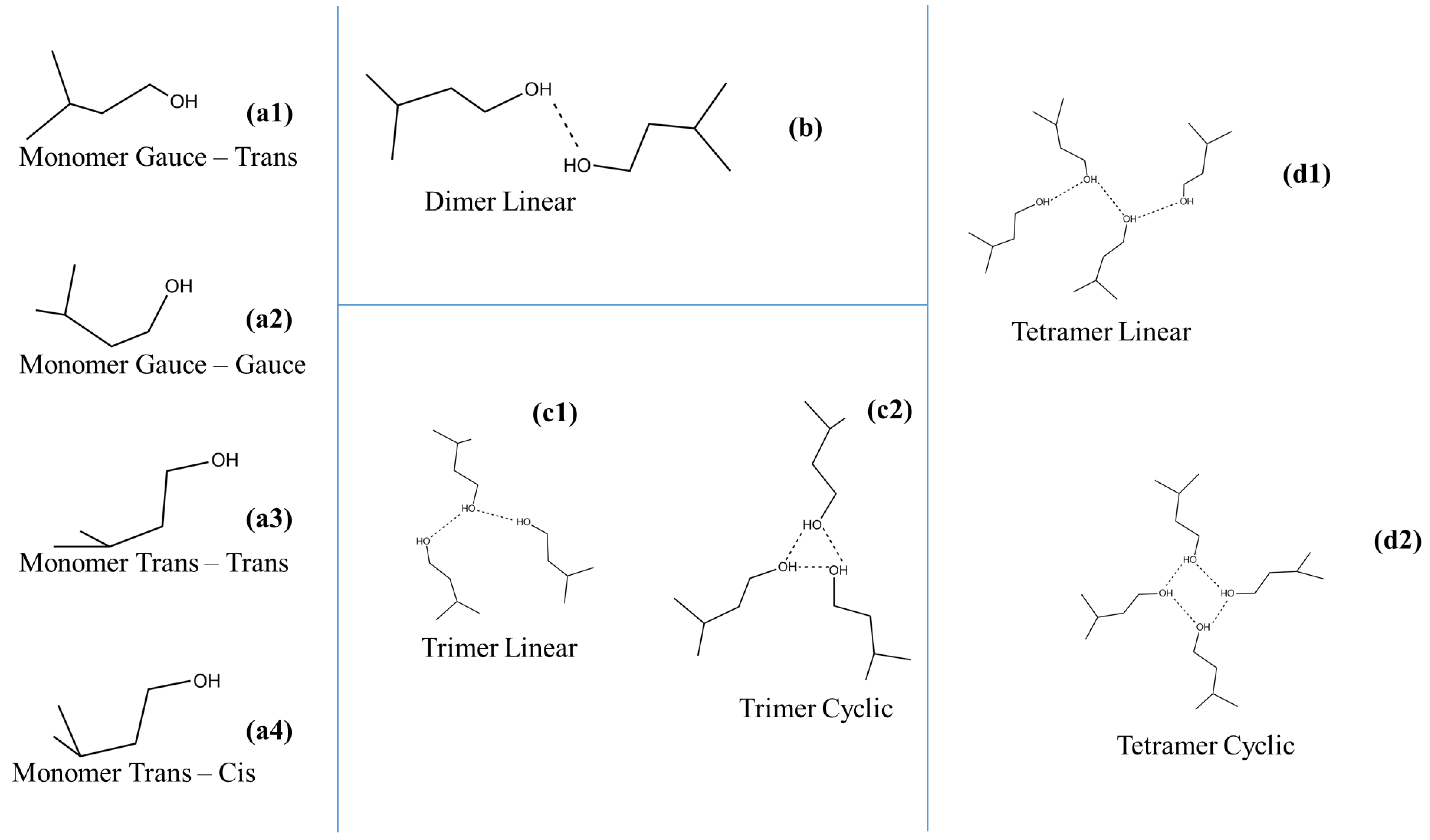
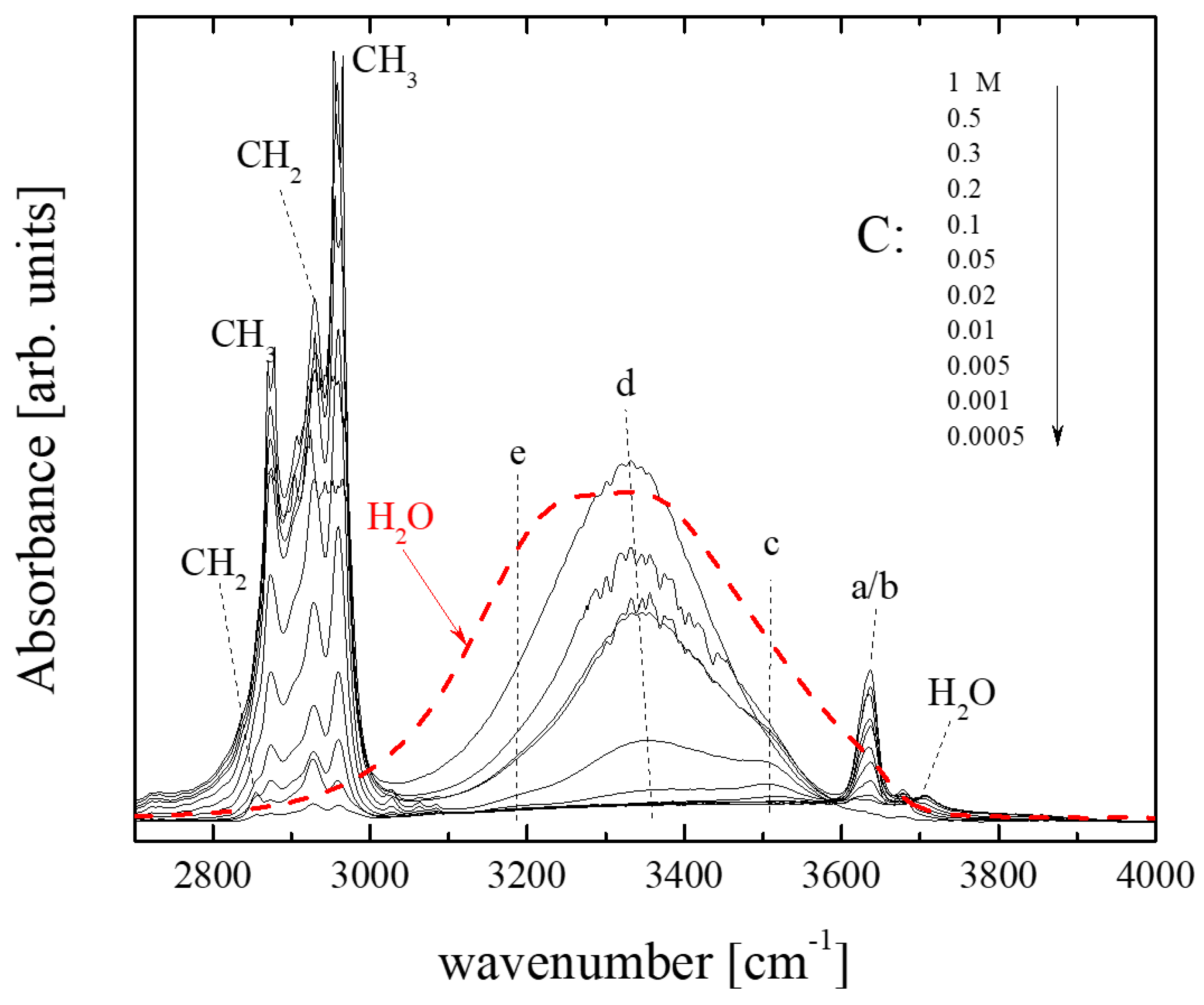

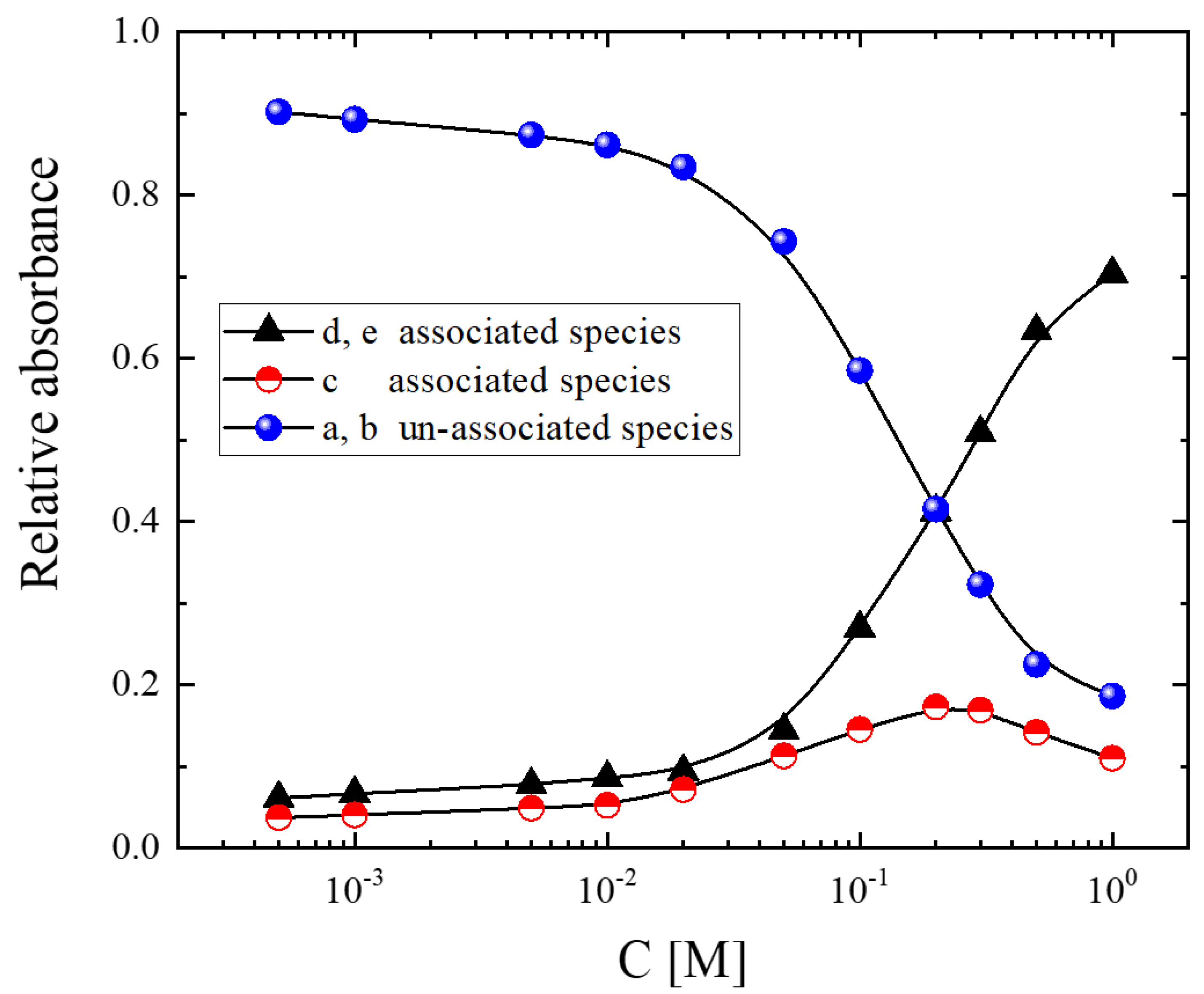


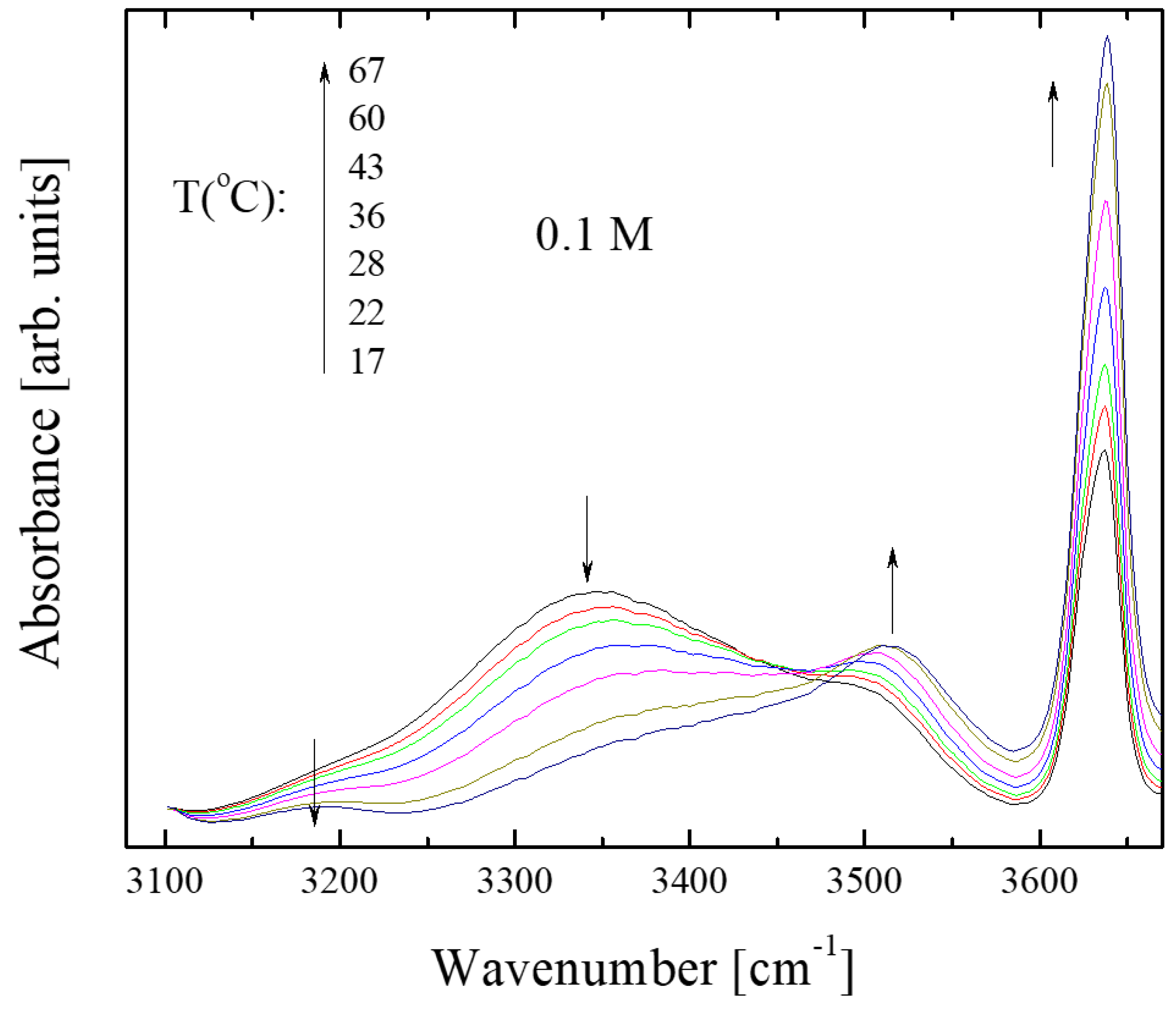
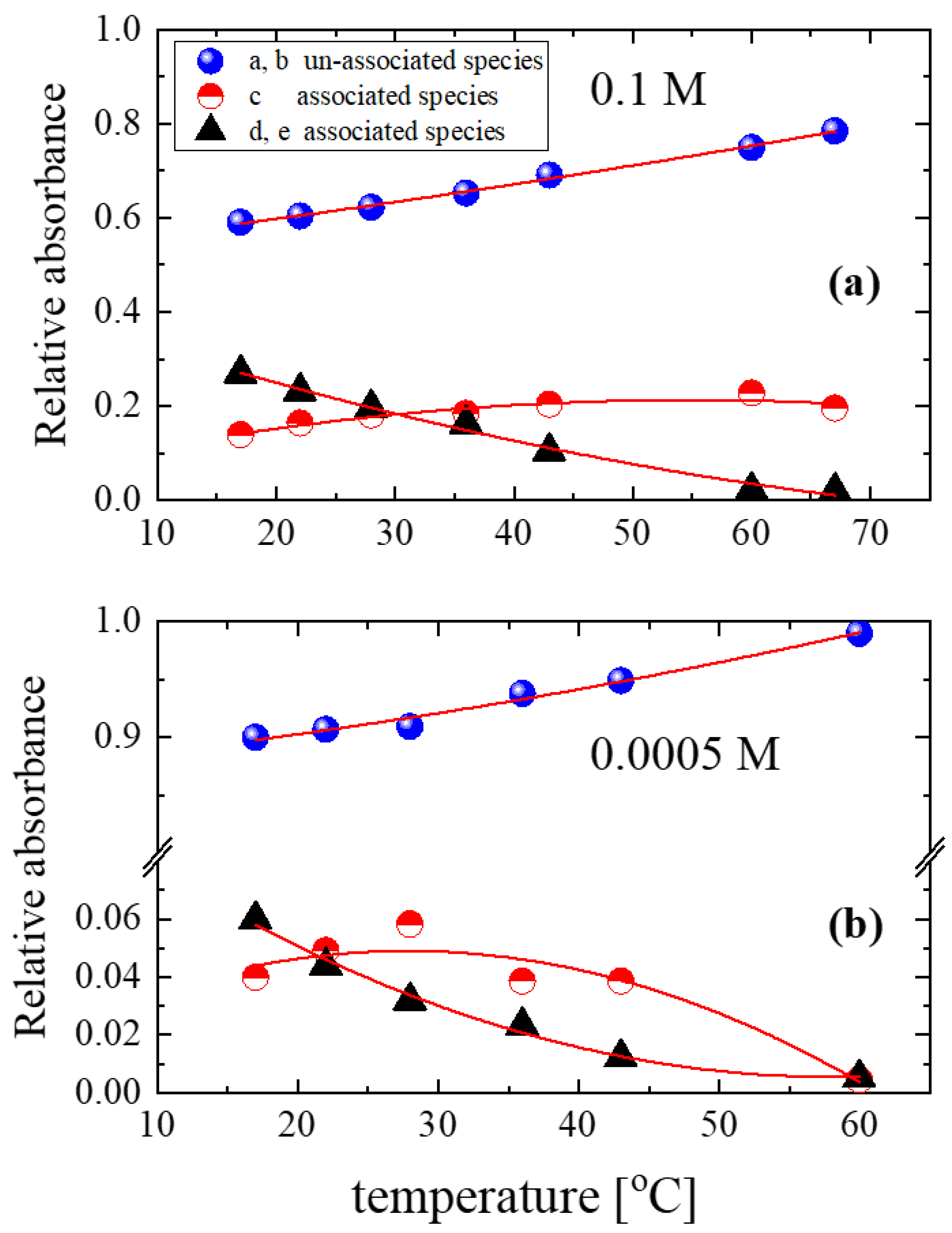


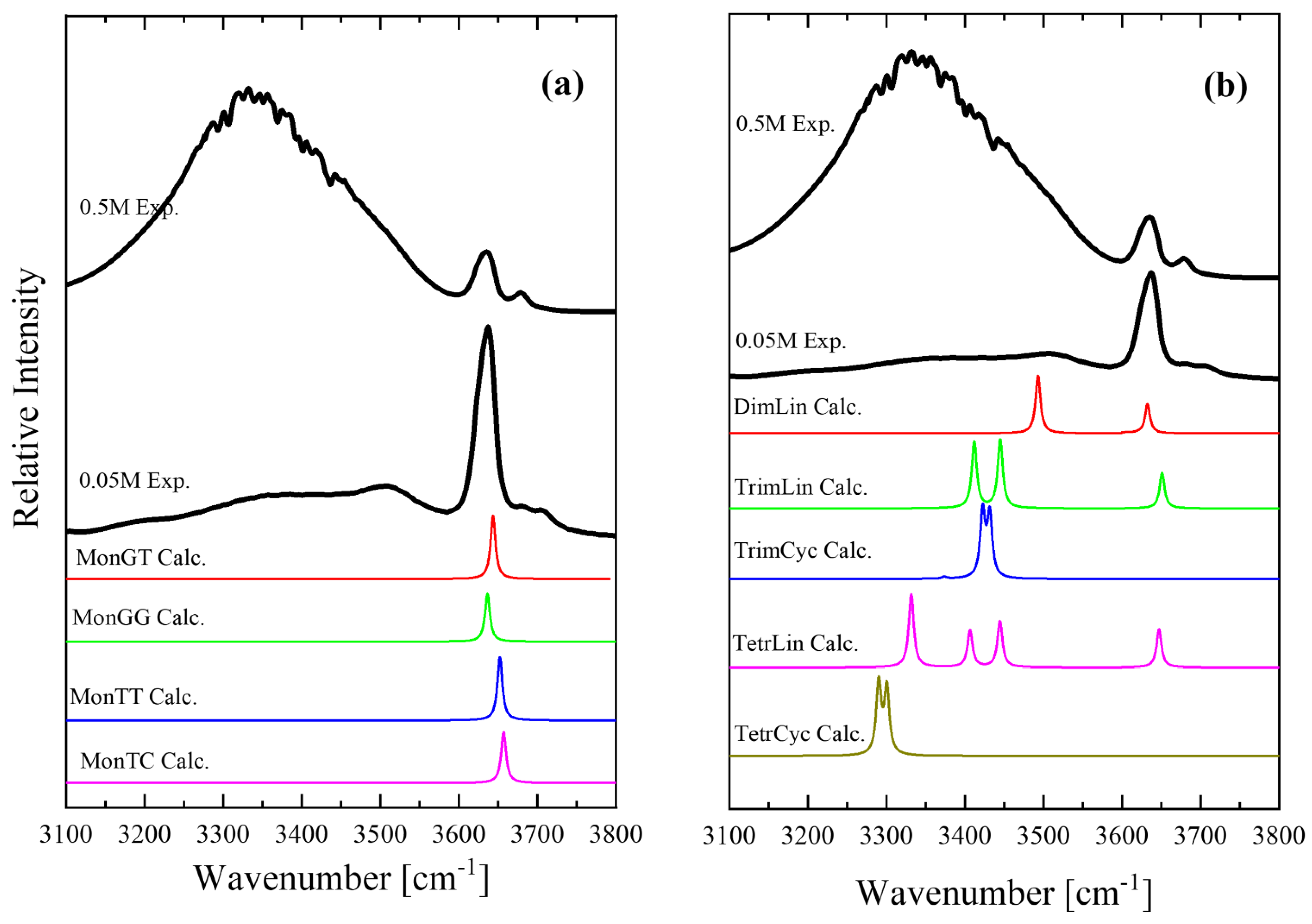
| Isopentyl Alcohol | ||||
| TO (O–C–C–C) | TC (C–C–C–H) | TOH (H–O–C–C) | Er (kcal/mol) | |
| Gauche–Trans (43%) | ||||
| B3LYP | 180.0 | 60.04 | 180.0 | 0 |
| MP2 | 170.0 | 59.98 | 172.14 | 524.185 |
| MP4 | 171.2 | 59.38 | 172.84 | 481.056 |
| Gauche–Gauche (32%) | ||||
| B3LYP | 65.57 | 171.81 | 61.14 | 1.750 |
| MP2 | 61.61 | 166.86 | 59.53 | 525.659 |
| MP4 | 62.22 | 167.85 | 59.58 | 482.594 |
| Trans–Trans (24%) | ||||
| B3LYP | 180.0 | 180.0 | 180.0 | 1.186 |
| MP2 | 180.0 | 180.0 | 180.0 | 525.107 |
| MP4 | 180.0 | 180.0 | 180.0 | 481.979 |
| Trans–Cis (1%) | ||||
| B3LYP | 180.0 | 180.0 | 0.02 | 2.221 |
| MP2 | 180.0 | 180.0 | 0.05 | 526.456 |
| MP4 | 177.79 | 178.83 | 56.45 | 482.173 |
Disclaimer/Publisher’s Note: The statements, opinions and data contained in all publications are solely those of the individual author(s) and contributor(s) and not of MDPI and/or the editor(s). MDPI and/or the editor(s) disclaim responsibility for any injury to people or property resulting from any ideas, methods, instructions or products referred to in the content. |
© 2023 by the authors. Licensee MDPI, Basel, Switzerland. This article is an open access article distributed under the terms and conditions of the Creative Commons Attribution (CC BY) license (https://creativecommons.org/licenses/by/4.0/).
Share and Cite
Tsigoias, S.; Kouderis, C.; Mylona-Kosmas, A.; Kalampounias, A.G. Intermolecular Hydrogen Bonding in Associated Fluids: The Case of Isopentyl Alcohol Dissolved in Carbon Tetrachloride. Molecules 2023, 28, 6285. https://doi.org/10.3390/molecules28176285
Tsigoias S, Kouderis C, Mylona-Kosmas A, Kalampounias AG. Intermolecular Hydrogen Bonding in Associated Fluids: The Case of Isopentyl Alcohol Dissolved in Carbon Tetrachloride. Molecules. 2023; 28(17):6285. https://doi.org/10.3390/molecules28176285
Chicago/Turabian StyleTsigoias, Stefanos, Constantine Kouderis, Agni Mylona-Kosmas, and Angelos G. Kalampounias. 2023. "Intermolecular Hydrogen Bonding in Associated Fluids: The Case of Isopentyl Alcohol Dissolved in Carbon Tetrachloride" Molecules 28, no. 17: 6285. https://doi.org/10.3390/molecules28176285
APA StyleTsigoias, S., Kouderis, C., Mylona-Kosmas, A., & Kalampounias, A. G. (2023). Intermolecular Hydrogen Bonding in Associated Fluids: The Case of Isopentyl Alcohol Dissolved in Carbon Tetrachloride. Molecules, 28(17), 6285. https://doi.org/10.3390/molecules28176285







